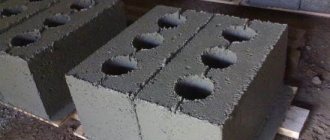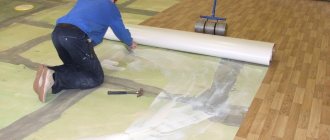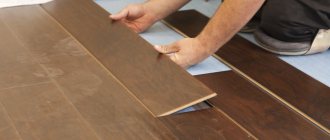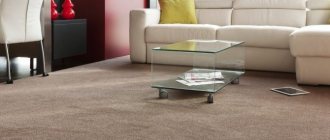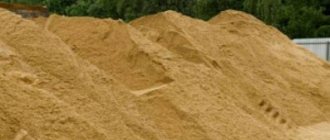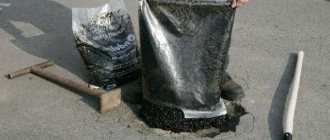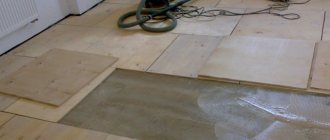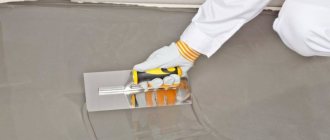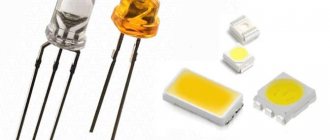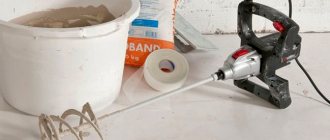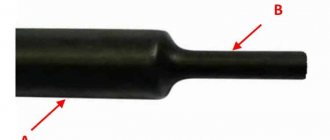One of the questions that inevitably arises before those who have chosen linoleum as a flooring material is whether it is necessary to lay a backing underneath it. This is a fair question and experts disagree. However, it is obvious that in search of an answer it is worth taking into account the type of linoleum, its structure, as well as the type and properties of the base on which it is to be laid. About the role of auxiliary materials, in particular about the advantages that cork backing for linoleum - today's material - has.
Cork backing for linoleum
The role of cork underlay when laying flooring
With the help of a cork substrate, it is primarily possible to level out minor unevenness of the base if it is concrete. If it is wooden, then the underlying material acts as a damper layer between the rough and finished floor covering.
The main functions performed by the cork substrate are as follows:
- High-quality compensation for defects in the floor, which is the rough foundation. Laying linoleum is associated with high-quality leveling of the base; if the difference is insignificant, then you can get by with a cork backing.
- Cork has thermal insulating properties due to components in its structure that significantly reduce heat transfer. As a result, the cork coating is endowed with insulating qualities.
- Using a cork layer you can significantly increase the sound insulation in a room. This is especially true in multi-storey buildings.
Cork sheet material
Note! The cork has a honeycomb-like structure with a gaseous mixture inside. Each cell has 14 edges, and their number per 1 cm³ of cork wood is 40 million. It is this unique structure of the material that made it moisture resistant, endowed it with remarkable thermal insulation properties and the ability to not allow volatile gases to pass through.
Technical cork is made from the bark of the cork tree, which is crushed and then pressed, followed by steam treatment. The particles stick together due to the suberin contained inside the cork, a natural adhesive substance. Therefore, all cork materials are environmentally friendly and safe for humans and the environment.
When purchasing, it is important to pay attention to the integrity of the packaging and storage conditions of the material.
About the need for underlayment under linoleum
So, craftsmen have been arguing about the need for a substrate for quite a long time. Some claim that it is really needed, while others, on the contrary, consider it a waste of money and effort.
The debate about whether a backing is needed for linoleum continues to this day.
In reality, it is impossible to answer this question unambiguously, because there are situations when it is impossible to lay a floor covering without an insulating substrate, and sometimes this stage is skipped altogether. In any case, before deciding whether a foundation is needed, you need to become familiar with the main functions it performs.
What are the sizes of linoleum
- Soundproofing. This function is especially relevant for residents of city apartments, since a high-quality substrate can protect against noise coming from neighbors below.
- Thermal insulation. The function will be especially useful if the apartment is located above an unheated room or on the ground floor.
- Additional leveling of the rough base. The concrete floor, which usually has various cracks, protrusions and other defects, will not come into contact with the linoleum, so they (the defects) will not be noticeable. In addition, due to such depressions, linoleum can wear out faster.
The additional layer protects against sounds from the neighboring apartment and serves as floor insulation
Advantages and disadvantages of cork substrate
To decide whether an additional insulating layer is necessary when laying linoleum in the form of a cork backing, you need to take a closer look at its advantages and disadvantages.
The positive qualities of the material include the following:
- The material has high wear resistance and a long service life.
- As a result of using the substrate, the load on the finishing coating is distributed evenly.
- The cork backing reliably protects the finishing material from dampness and moisture, which can penetrate from below through the base. This is relevant when laying material on the ground floor on a concrete base, especially if there is an unheated subfloor underneath it.
- Also, a cork backing will protect the room from cold penetration from below and from heat loss through the ceiling.
- The material is hypoallergenic and environmentally friendly, so it can be used in residential premises, bedrooms and children's rooms, where a high-quality microclimate is especially important.
- Cork has excellent shock-absorbing qualities and is capable of quickly restoring its original condition after removing a point load. In combination with linoleum, which has the same properties, such a substrate is simply irreplaceable.
- The moisture resistance of the material allows it to be used even in the bathroom.
- The material is a dielectric.
Structure of cork material
Like any other material, cork has disadvantages. The main one is the high cost of the material. It is not logical to choose an expensive substrate for cheap linoleum, but it is quite justified when using high-quality, natural material, for example, marmoleum. It is also worth remembering that such a substrate is not used in the “warm floor” . In this case, it is recommended to use foil-clad artificial materials.
Note! In order for the cork substrate to last a long time and retain its performance properties, it is necessary to meet certain technological conditions. In particular, the residual moisture of the base when laying cork should not exceed 2.5%, and air humidity - 75%. The room temperature should not fall below +10 degrees.
Roll material is most often supplied with a web length of 10 m
Video - The advantage of cork backing
What types of substrates are there?
Substrates are made from different materials, both artificial and natural. In order to choose the right option, familiarize yourself with the available types of foundations, study their advantages and disadvantages.
It is important to choose the right substrate
Cork backing
It consists of pressed wood fibers, does not contain additional additives, and therefore is environmentally safe. This type of underlay is often used for concrete floors because:
- has a long service life (about 28 years);
- can be used in any premises, regardless of their purpose;
- has good soundproofing characteristics.
Cork sheet backing
The substrate is sold in rolls 1 m wide, and therefore is easy to transport and install. There are several types with different thicknesses (ranging from 2.5-9 mm). The denser it is, the softer the floor will be and the worse the performance characteristics will be.
As for the disadvantages, in this case they are the following:
- high price. One roll will cost 1500-8500 rubles, that is, the substrate is often more expensive than the linoleum itself;
- Under heavy objects, unsightly dents will appear over time, so rearranging always involves replacing the backing.
Cork backing
Jute backing
Another material of natural origin, which has a number of advantages.
- Cheapness. A roll 10 m long costs about 1100-1400 rubles, that is, the jute base is much cheaper than the cork base.
- Hardness. The material will retain its original shape even if heavy furniture is placed on it.
- Availability of several types of substrates with different densities.
- Long service life. The material can last more than 70 years - longer than linoleum itself (in case of replacement of the coating, such a substrate is not dismantled).
- Fire and moisture resistance. The material does not burn and has good protection against moisture.
Jute backing
There is only one minus: if there are dents on the subfloor, they will definitely appear over time.
Linen backing
Outwardly similar to jute, but differs in such advantages.
- Environmentally friendly. This material is natural; no adhesive components are used in its production.
- Affordable price. 10 sq. m of material will cost about 1000 rubles.
- Soundproofing. This type of substrate is less durable than jute, but has good soundproofing properties.
- Various thicknesses (2.5-6 mm). Typically, 4 mm thick material does an excellent job of masking defects.
- Breathability. This minimizes the risk of fungal development.
Linen backing
As for the downsides, there are practically none. The only exception is that the substrate is sometimes difficult to find in stores due to low production volumes. In addition, it is not very popular in Russia.
READ MORE: How to insulate a floor in a dacha - two best ways - step-by-step instructions
PET substrate
An artificial material with its own advantages.
- Low cost. This option is the cheapest of all existing ones, it costs approximately 25-30 rubles. for 1 sq. m.
- A large assortment. The substrate is sold not only in rolls, but also in panels (the second option is denser, so it is better to use it).
- Availability. The material can be purchased at any hardware store.
Polyethylene backing
But there are also disadvantages that you also need to be aware of.
- Short service life. After only 4 years, the base will become unusable and will have to be replaced.
- Impervious to air. Consequently, fungus will develop under the floor covering. As you can see, it is better not to buy such a substrate, regardless of its cheapness.
NPE based substrate
It combines wool, jute and linen, thanks to which it received such advantages.
- Excellent thermal insulation. This is ensured mainly by the presence of natural wool.
- Affordable price. For 1 sq. m need to pay about 180 rubles.
- Strength, durability. The material can last up to 45 years, withstanding almost any load.
But there are also disadvantages - this is, first of all, a large number of low-quality products on the market, outwardly practically indistinguishable from the original.
Coniferous substrate
Made from pressed coniferous fibers, it has excellent heat and sound insulation qualities. It also contains pine resin, and therefore prevents the development of fungus. The disadvantages include deformation some time after installation, as well as the characteristic smell of pine needles in the room, which, however, disappears after a few days.
Coniferous substrate
The material is of synthetic origin - a double layer of PET, in the middle of which there are granules. Thanks to this, the substrate acquires good heat and sound insulation characteristics.
Composite
backing for Tuplex linoleum
When is the underlay useful?
The unique performance properties of cork - sound insulation, insulation, moisture resistance, environmental friendliness and durability - speak about the quality of the material.
Method for determining base unevenness
However, it should only be used in certain cases:
- In the presence of irregularities that remain after leveling the base using local repairs or pouring screed. In this case, the cork will smooth out minor errors that should not be excluded. Thus, the service life of linoleum will be significantly extended.
- When using a baseless coating. It is worth recalling that linoleum can be multi-layered or single-layered. The first option may have a fairly dense bottom layer, which serves as a substrate, but in the second case, a substrate is simply necessary, since a single-layer material does not have sound and heat insulation properties.
- Cork coating is also necessary for concrete foundations. Due to the cork, the floor covering will not be cold, and the comfort of its use in a residential area will increase.
Recommendations for identifying base irregularities
Preparation for installation
After the choice has been made, let's hurry up and lay down the substrate, and try to understand the main features of this process. First of all, you should determine what kind of lining you have: sheet or roll. Both roll and sheet have their own characteristics. They differ, first of all, in size and, of course, price.
When this issue is resolved, some more preparatory work needs to be done. Despite the fact that the underlay perfectly serves as a leveler, it is better to take extra care to eliminate all possible unevenness on the floor. If the floor is made of boards, chipboard slabs laid out around the perimeter of the room in a checkerboard pattern are well suited for this purpose. In this case, the seams and bases of the lining, in the best situation, should not match.
- If the floor is, for example, concrete, you must first make sure that it is level and does not contain serious defects.
It is necessary, as far as possible, to get rid of all unevenness and defects, all slopes and differences in height and floor level. All noticeable defects should be eliminated: the substrate will only cope with those that do not exceed in height half the height of the substrate itself. After the preparatory work on leveling the floor is completed, it is better to also carry out waterproofing.
It should also be remembered that concrete floors are very vulnerable to moisture and may be subject to evaporation. In order to protect the floor from such a process, it is better to use a special film between the floor and the lining, as well as between the lining and linoleum. The joints between the film can be sealed with waterproof tape.
After we have dealt with all the preparatory work, we can begin the installation itself. It’s worth mentioning right away that the lining, as a rule, is not firmly and permanently attached to the base. There are several reasons for this. The first of them is material: there is no need to purchase a large amount of glue to lay and secure the substrate around the entire perimeter. Not every glue is suitable for such work, which gives an additional reason to save on it.
It is best to place sheets of cork backing close to each other. Each subsequent layer of roll lining should also be laid as close as possible to the previous one. The seams between the layers and sheets are glued together using special construction tape.
In general, the process of laying cork backing does not have any other features. You just have to remember basic precautions and also that the humidity in the room in which the substrate is being laid should not exceed 60%, and the air temperature should not be lower than 18 degrees.
After all work on laying the substrate has been completed, you can begin laying the linoleum itself. In this process, it is also important to understand which linoleum is best and why. Regardless of the choice, you should be as careful as possible so that none of the work performed has to be done twice.
Laminate underlay thickness
Warm floor under linoleum
Floor screed for laminate
After leveling the surface and clearing debris, the process of installing the substrate consists of the following steps:
- Laying the insulating layer. As with a concrete floor, before laying linoleum on a wooden floor, it is advisable to lay down regular plastic film. It will protect the wood from moisture and create the necessary insulation.
- Underlayment flooring. The rolled material is laid in strips without overlaps - end-to-end, then they are connected with sealant or special tape.
Before laying the underlay on a wooden floor, it is necessary to fill all holes, cracks and uneven areas.
After this, you can begin laying linoleum on a wooden floor. If plywood is used as a substrate, then the process is more labor-intensive, it involves the following sequence of work:
- surface primer. Before laying linoleum on a wooden floor, the surface is cleaned of old paint and a primer is applied to it;
- Installation of plywood is carried out after the primer has completely dried. The plywood is laid with some offset. The distance from the sheet to the wall must be at least 5 mm;
- plywood fastening. For fastening to a wooden base, it is best to use self-tapping screws, which are easy to use and can provide reliable fixation;
Before laying the substrate, it is necessary to lay an insulating layer to protect it from moisture
- elimination of defects. The burrs are removed from the edges of the plywood sheets using a plane, and the depressions in the places where the screws are screwed in are covered with putty.
There are many tips and recommendations online on how to properly lay linoleum on a wooden floor. Summarizing them, we can come to the conclusion that the direct laying of linoleum itself is a simple process, which is preceded by more painstaking preparatory work. The material itself spreads easily.
For finishing high-traffic floors, it is better to use commercial linoleum.
It is recommended to use commercial linoleum as floor finishing in high-traffic areas. GOST characteristics of such a floor covering indicate a high degree of strength and durability, superior to laminate. The quality of the flooring is evidenced by a special quality certificate from the manufacturer.
READ MORE: How to prepare a floor for laminate: base, laying on a self-leveling floor, do-it-yourself preparation, priming concrete and wooden floors, photos and videos
More flexible types of material are quite easy to attach. It is enough to carefully level the coating and then lubricate the edges with special glue. The final fixation will be provided by the installation of skirting boards. If there is uncertainty in actions and fear of spoiling expensive material, then it is recommended to entrust the work to professionals.
Thus, it is not necessary to always use a linoleum underlay, but sometimes you simply cannot do without it. As an additional material, it contributes to the qualitative improvement of the floor. The main thing is to decide on the set of functions required from the substrate and choose the right option. Laying the material is quite simple.
When purchasing flooring, take into account the size of the room in which it will be installed. If the colors are chaotic, you won’t need to select a pattern when joining.
Laying algorithm:
- Roll out the linoleum so that the edge rests against the wall and does not need to be cut. The technical gap (distance from the edge of the wall to the linoleum) during initial installation should be 5-10 mm.
- Cut off the linoleum. You need to start from the outer corners in front of the doorways. Lift the linoleum and fix it, pressing it firmly with your foot at the base. Carefully cut with a knife to the floor, making sure to leave a slope of 5 mm inward. This is done on both sides. The linoleum should lie down without touching the walls. Do the same with internal corners, leaving a slope of 2 mm. The template is ready, and when it has rested, you need to look through it and, if necessary, trim off the excess.
- Trim a line along the wall where there is excess material. Carry out the cut by pressing the linoleum into the corner as much as possible. Cut strictly along the fold line, leaving a distance of no more than 10 mm, continuing along the perimeter.
- Determine how to bypass the pipe. Place the linoleum on it and cut it with a knife, moving vertically, in the middle of the pipe to the floor. Cut off by a centimeter, press down and push the linoleum close to the pipe. This way you can get around it. Pull out the linoleum, it will be noticeable that you have 2 semicircles, which can be cut arbitrarily with a knife.
- Now the linoleum needs to rest. This may take from 1 to 6 days. In places where it rests on the walls after laying down, it must be trimmed so that the gap does not exceed 10-15 mm.
- It is important to figure out how to process the joint. One half of the linoleum is rolled up. Using a simple pencil, a line is drawn on the floor along the edge that remains unwrapped. Remove it, clean the surface with a brush, and stick double-sided tape along the resulting line in the middle. Every 10 cm it needs to be smoothed by hand. Remove the top layer of paper. Unroll one strip of linoleum and place it on the tape. Flatten with your hands, moving from the fold to the seam, avoiding the appearance of waves. Do the same with the second part. The seam should be cold welded with a needle. To do this, initially apply masking tape in the middle of the seam. A needle is used to pierce the seam, pressing on the tube of cold welding and moving along the entire joint. After 10 minutes, the glue is cleaned off and the paint is removed.
- You can also make the joint in a different way, when you have to join a non-factory seam. With this option, two parts of linoleum overlap. You need to place a ruler along the future seam, press it very tightly, you can use your foot. The main task is to cut through 2 pieces of canvas at the same time. Cut so that the knife blade does not wander. Unnecessary pieces are removed. A perfect line is formed at the cut site. Then the joint is processed.
- The final stage is installation of the plinth.
Step 1. First of all, you have to level the base, so first clean it of dirt and debris remaining after dismantling work. Then treat the floor with a primer, adding an antifungal agent to it (all damage must be carefully treated).
Next, level the base with a screed. If there are depressions, cover them with cement mortar, adding PVA glue to it (this will prevent cracks from appearing again). You can also use adhesive designed for laying ceramic tiles.
Preparing the subfloor
Step 2. Lay a waterproofing layer, which is required for very damp surfaces. Take the PET film and spread it over the concrete base. It is advisable to use a large canvas so as not to connect individual parts of the material. When using multiple strips, secure them with adhesive tape.
The film is not fixed to the floor surface; this occurs by laying subsequent layers
- A drill with a mixer attachment for preparing cement mortar is only needed if you plan to pour a cement screed.
- Screwdriver.
- Building level.
- Roulette.
- Hacksaw or jigsaw.
- Brush or roller.
- Stationery (construction) knife.
- Mallet.
- The first step is to remove all construction dust from the surface.
- Seal all cracks and potholes with cement mortar.
- If necessary, it is necessary to pour a concrete screed to level the floor (if the base has differences of more than 3-4 cm per square meter).
Before laying the plug, it is necessary to cover the concrete base with plastic film
Types of cork-based substrates
Cork substrates are distinguished by the presence of additional components that affect the performance properties of the material.
Regular (classic) substrate without additives
This variety contains exclusively natural ingredients, so this type of substrate is the most environmentally friendly and safe. It can be used in the bedroom and children's room. This variety has fire-fighting (thanks to special impregnations), antiseptic and dielectric properties.
Traditional cork material
Bitumen-cork substrate
This type of underlay is intended for technical rooms. To make this variety, kraft paper with additional bitumen impregnation is used. During the manufacturing process, cork chips are pressed in an even layer onto a bitumen-paper base. The main advantage of the material is its high waterproofing properties. The material is fire hazardous and therefore not intended for residential premises.
This substrate is produced in the form of rolls and sheets, which are easy to process - trimming, bending, when joining to surfaces of complex shapes.
Substrate with bitumen component
Rubber-cork backing
The binder in the structure of this type of cork substrate is rubber. The main range of applications is rooms with high humidity. This substrate can be used on any base - wood or concrete. The material has high elasticity, vibration resistance and shock-absorbing properties.
Backing with added rubber
Underlay value
But, understanding the properties of such a material as linoleum, perhaps you can change your decision regarding the substrate. So, in most cases, the purchased linoleum is a polyvinyl chloride fabric.
This coating is cold in the sense that linoleum does not have thermal insulation properties. The same is true with sound insulation. All these problems can be successfully solved by using a substrate.
If we consider substrates made from natural materials, then products made from cork will have the highest heat and sound insulation properties.
In addition, this material is moisture resistant and does not allow volatile gases to pass through, it is not susceptible to rotting and mold.
It is safe to say that cork is the best material of all available types of substrates. Therefore, its price is higher than that of analogues. And yet, if you need to get a high-quality base for linoleum, then it is better to give preference to cork material.
Installation of cork underlayment under linoleum
Cork underlay for linoleum can be laid both on a concrete floor and on a wooden floor. If the cork underlay is laid on a wooden floor made of boards, then it is advisable to cover it with gypsum fiber sheets or chipboard.
You just need to remember that the cork tends to press through, so a layer that is too thick will also be unnecessary. If the unevenness and differences in the floor are too large, or are located over its entire area, then, of course, it is better to make a screed.
The underlay should be laid on a clean and dry floor. If necessary, additional waterproofing in the form of polyethylene film can be made under the substrate.
When laying the floor, mechanical fixation methods are not applicable. It is attached with glue. Although you don’t have to attach the substrate to the base in any way. In this case, when laying, you should fasten the sheets of substrate together with construction tape.
Cork backing is sold either in rolls or in sheets of different sizes . If you are going to lay the underlay from a roll, then you need to leave it unrolled for a day.
If laying is done with sheet material, then it is better to lay it in a checkerboard pattern to prevent the seams from coming apart under load.
Laying work must be carried out at room temperature not lower than 18 degrees Celsius and air humidity not exceeding 60%.
Linoleum does not stick to the substrate over the entire area. If the room is small, then the linoleum is simply laid on the prepared base, leveled and secured with skirting boards around the perimeter.
If joints between sheets of linoleum are planned, then double-sided tape can be used for fastening. It is glued to the backing at the seam of the linoleum.
You can also use so-called cold welding - glue with a special composition. It is applied to the joints and a completely sealed connection is obtained.
As a result, it should be noted that the cork backing for linoleum has received very good reviews.
Those who have already used this method of laying flooring note that the floor is warm enough that it is comfortable to walk on even barefoot.
They also indicate good shock absorption of the floor - it softens falling objects. They praise the ease of installation, the resulting smooth surface, a good level of sound insulation, and the absence of unpleasant odors.
The negative aspects are the rather high price and slight subsidence of the coating under heavy furniture, which we have already discussed.
Still, there are more advantages to using cork underlay for linoleum than disadvantages.
Source
Price for cork substrates
Undoubtedly, cork underlayment is not a cheap material, but it can affect the thermal efficiency of a living space. If the floors are cold, then quite a lot of money will be spent on paying for heating using additional heat sources. By laying a cork underlay, you will be able to effectively insulate a cold floor, and the cost of purchasing it will soon more than pay for itself.
Table 1. Cost of cork substrate
| Illustration | Name and characteristics | Average cost as of November 2021, rubles |
| Manufacturer: Izora, thickness 3 mm, roll 10 m². | 1950 | |
| Technical cork 10 mm (sheets) Wicanders, Sheet size 915*610*10 mm, In one package: 0.56 m² | 930 | |
| Country of origin: Portugal, Roll length 10 m, Thickness 2 mm. | 1050 | |
| Country of origin: Portugal, Roll length 10 m, Thickness 2 mm. | 1500 | |
| Manufacturer: Amorim (Portugal), Thickness 4 mm. | 2750 | |
| Manufacturer: Cork4u (Portugal), Thickness 3 mm, Roll 10 m². | 2050 | |
| Manufacturer: Wicanders, Sheet thickness 6 mm, Sheet size 915x610x6 mm. | 550 | |
| Manufacturer: Granorte Braim Amorim (Portugal), roll 10 m², thickness 2 mm. | 1250 | |
| Manufacturer: Granorte Braim Amorim (Portugal), roll 10 m², thickness 3 mm. | 2250 | |
| Manufacturer: Granorte Braim Amorim (Portugal), roll 10 m², thickness 4 mm. | 3100 | |
| Manufacturer: Granorte Braim Amorim (Portugal), roll 10 m², thickness 5 mm. | 3800 | |
| Manufacturer: Granorte Braim Amorim (Portugal), roll 10 m², thickness 6 mm. | 4250 | |
| Manufacturer: Granorte Braim Amorim (Portugal), roll 10 m², thickness 10 mm. | 7900 |
Concrete base
The optimal solution for installing linoleum is a concrete base that has undergone special preparation. If there is serious damage to the concrete base, it is advisable to install a new screed or apply a self-leveling mixture to the surface .
Before laying linoleum, you should install the underlay . Since, as already noted, a concrete floor does not have high thermal insulation properties, additional installation of insulating materials may be required. These can be wood-based materials - chipboard and plywood .
Next, a cork backing under the linoleum is laid on the prepared sheets. It is fixed in different ways, including with glue . The linoleum itself is laid using the same technology. It is worth noting that cork slabs are also good because they facilitate installation processes . Their smooth surface allows you to glue the canvas without fear of spoiling the appearance of the future floor.
Return to content
Laying - main nuances
When laying cork underlayment, it is recommended to take into account the following features.
If the cork backing is laid on a wooden base, then the waterproofing layer can be omitted - cork will do the job just fine.
Laying the substrate on a flat plywood base
Laying the backing is not difficult and does not require special skills: sheets or fragments of rolled material are laid end-to-end on an adhesive base or on double-sided tape at the joints. The top joints are also taped with tape.
Cork is easily cut using a regular construction or stationery knife
When laying sheet material on a wooden base, the seams must be spaced to avoid displacement of the material under load.
Be sure to remove debris and protruding fragments from the surface of the base and repair obvious damage.
When laying linoleum on the first floor on a concrete base, a polyethylene waterproofing layer is fixed under the substrate. In this case, the cement or wooden base should be treated with primer with anti-fungal properties.
Fixing the substrate with adhesive composition
For a “warm floor” system, a cork underlay is not recommended, since it will transmit no more than 20% of the heat radiated from the floor surface.
Warm floors are a serious cost item during renovation, so it is important to accurately calculate how much and what materials will be needed. To ease your labor costs, we have prepared special instructions telling you how to calculate a heated floor - water or electric. Online calculators included. And in the article “ What do you need for a heated floor? » you will find a complete list of everything that may be needed during installation.
Fixing end-to-end with double-sided tape
Before fixing the substrate, it must be kept in an unfolded room for 24 hours at room temperature and humidity not exceeding 60%.
Laying on a polyethylene waterproofing layer in an apartment
To avoid displacement of the substrate in a large room, linoleum sheets are laid across its direction. Waterproof tape is used to seal the joints.
Sealing joints with waterproof tape
Note! With high load-bearing strength, the cork substrate is vulnerable to sharp objects and point impacts, especially at the edges of the material. Therefore, at the stage of fixing the material, you should act carefully.
When working with cork backing, you must try not to damage the edges and fabric.
To avoid the formation of dents on the surface of linoleum under point loads from massive furniture and equipment, a substrate of small thickness will allow you to avoid it - 2 mm is quite enough.
Prices for Tarkett linoleum
linoleum tarkett
Base for linoleum: underlay for concrete floor
Depending on the initial foundation, preparatory activities may vary. But in any case, all work should be aimed at achieving optimal qualities of the base in relation to its ability to be used as a base for laying linoleum. So, the surface under linoleum should be:
- reliable;
- tough and durable;
- horizontally aligned - critical limits extend beyond 2 cm;
- dry and clean;
- have no greasy or oily traces;
- have no residues from the previous coating, including traces of glue.
Now let's move on to a more detailed description of the coatings on which linoleum with a cork backing can be laid.
The optimal solution for installing linoleum is a concrete base that has undergone special preparation. If there is serious damage to the concrete base, it is advisable to install a new screed or apply a self-leveling mixture to the surface.
Before laying linoleum, you should install the underlay. Since, as already noted, a concrete floor does not have high thermal insulation properties, additional installation of insulating materials may be required. These can be wood-based materials - chipboard and plywood.
Next, a cork backing under the linoleum is laid on the prepared sheets. It is fixed in different ways, including with glue. The linoleum itself is laid using the same technology. It is worth noting that cork slabs are also good because they facilitate the installation process. Their smooth surface allows you to glue the canvas without fear of spoiling the appearance of the future floor.
Before you begin laying linoleum, with or without a backing, you need to study the technical features of the base and carefully prepare it. Linoleum itself is a fairly flexible and elastic material, so you need to take care to fulfill a number of requirements in relation to the base:
- the surface must be strong and smooth. Only smooth differences from 2 to 7 mm are allowed, so a preliminary leveling procedure by pouring the floor may be necessary;
- hardness of the floor base;
- the base must be perfectly dry and clean. If necessary, the surface is cleaned of old paint and removed from grease and oil stains.
Before laying linoleum, the floor must be carefully leveled
Fulfilling the requirements for preparing the base helps to extend the service life of linoleum. As for the base itself, it is divided, depending on the material, into the following types:
- concrete;
- wooden floor;
- old coating;
- tile;
- a plywood base covering a concrete or wooden floor (sheet materials such as plywood, fiberboard or OSB boards can either be the base for the floor or serve as a backing for the floor covering).
The underlay can only be laid on a dry, durable, hard and clean floor
Each type of base requires special preparation and method of installation of linoleum and the substrate under it.
Typically, linoleum plywood is used as a substrate on a concrete base. On wooden floors this technology is used even more often. Other wood-based materials are also used - fiberboard and OSB boards. Their main advantage is providing a perfectly flat surface. In addition, they guarantee the necessary rigidity of the base.
Fiberboard is the thinnest and most affordable material. Its thickness is up to 2 mm. For this reason, fiberboard is not suitable for laying on very curved floors, since the substrate quickly deforms, as a result of which the defects are reflected on the linoleum.
OSB is an order of magnitude stronger and thicker (from 6 to 12 mm) than the previous material, therefore it is more suitable for a base under linoleum. Such slabs will help level the floor, but before use you need to clearly determine the required level. At the same time, the material quickly wears out under the influence of loads, and part of the slab peels off over time, which leads to the formation of defects.
Wood-based underlays are ideal for concrete and wood floors
Based on the characteristics of the coating materials described above, plywood is the optimal material for a solid base. Its layered structure does not allow bending, which contributes to excellent floor leveling. The only downside to plywood is that it costs an order of magnitude more than other alternative solid substrates.
All wood-based materials have a common drawback: they are vulnerable to moisture, so they should not be laid in the kitchen or bathroom. Under the influence of humidity, wood panels begin to rot, changing shape and volume. All this negatively affects the main coating. Fibreboard can, like paper, become wet when exposed to moisture.
A concrete floor underlay is necessary for leveling and insulation
- base preparation includes cleaning and leveling the surface. After completing the concrete screed, the floor must dry completely. This may take up to 30 days;
- elimination of defects. After pouring the floor, small defects sometimes form. The tubercles can be knocked down or cut off, and the holes must be filled with a self-leveling mixture;
- waterproofing. After final drying, the surface is covered with a waterproofing layer. A simple polyethylene film covering the floor as a single sheet is suitable for this. It is imperative to provide an overlap of 3-4 cm on the walls;
- installation of the leveling layer involves laying plywood or other wood-based materials. Sheets of plywood are laid with a margin of 5 mm from the wall. Subsequently, the gap and seams between the plates are filled with sealant. Fix the material with small dowel nails (5 mm) at a distance of 60 mm from each other. The fastening material should not protrude, and dents should be covered with putty;
The rolled substrate is rolled out and laid end-to-end without overlap.
- roll backing flooring. The material is rolled out and laid end to end, without overlaps. The seams are taped with gray reinforced tape.
READ MORE: Welding linoleum at home - a review of technologies
If multilayer linoleum on a durable base is used as a floor covering, and the base has a perfectly flat surface, the underlay is not laid. For single-layer thin linoleum, use any of the types on the market.
To level out small unevenness in the screed, a cloth made of jute, wool and flax is used. It is best suited for strength and insulation properties. The use of sheet material is only possible if the concrete base is dry and there will be no strong fumes during operation.
Wood floors have excellent ventilation and do not require additional preparation for laying underlayment sheets. Other types will not be able to properly level the wooden base. It is advisable to lay single-layer linoleum on a jute or linen backing. The wooden base itself is warm and needs to be provided with good ventilation, which is possible when using one of these types.
To determine which linoleum underlay to choose, you need to study information about the floor covering used for residential premises. Household linoleum consists of:
- lower part made of polyester, fabric or jute;
- fiberglass fabric base;
- PVC pastes;
- “canvas” layer of polyvinyl chloride with a printed pattern;
- protective layer.
The substrate is applied to linoleum mechanically or chemically. When using glue, the cells of the fabric are closed, which significantly reduces the strength characteristics of linoleum. The mechanical method of applying the substrate does not change the structure of its cells, which makes the coating high-quality and extends its service life.
It is best to lay linoleum on a concrete base after careful preparation. The base is leveled using special mixtures. After applying the screed, the base must be left to dry completely for at least 4 weeks.
Important! Before starting work on installing the floor covering, it is necessary to check the floor surface for moisture. To do this, a kissing mat is placed on the base and secured at the edges with tape. After 12 hours, his condition is checked. If there is no dew on the oilcloth, the base is ready for laying the floor covering.
Before laying the underlay and floor covering, the screed is cleaned of dust and a waterproofing layer is applied.
Linoleum can also be laid on a base of ceramic tiles, after gluing the loose elements, sealing all damaged seams, and carefully removing grease stains and dirt. The underlay is used only if a single-layer coating is laid or it is necessary to additionally insulate the base.
Let us summarize the material presented. Before using a linoleum substrate, the base must be carefully prepared: leveled, dried, cleaned of dirt and dust, and applied a waterproofing layer or primer. The canvas is simply laid on the base. The sheets are fastened together with moisture-resistant tape. Installation of the balsa wood substrate should be done at a temperature of 18 degrees and above. Air humidity should be no more than 60%.
Linoleum on linoleum
This installation method has both advantages and disadvantages. It all depends on the condition of the old coating . If it is unsatisfactory and requires replacement, then it is recommended to completely dismantle it and lay new material on the rough base. However, if the coating is in optimal condition for further use, then it can be laid directly on the existing linoleum . In this case, the cork substrate only enhances the effect of heat and sound insulation , and the main carrier of the insulating qualities is the old linoleum.
Source
